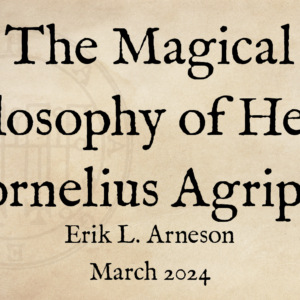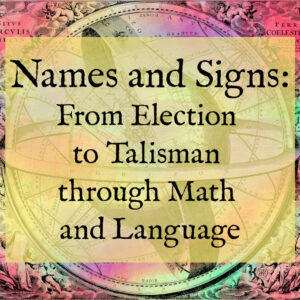I have just released a new online tool for generating Playfair cipher keys using whatever text you feel like using. While this may seem like an unusual tool for a website like this, those who have taken my class, The Other Trithemian Art, or heard me talk about using modern hand-ciphers with Renaissance magical techniques, have learned how I use this. I’ll give a brief example of its use below.
I used three different MIDI keyboards and a bunch of sound effects to create this soundscape-rich taiko-drum-driven musical interpretation of the story of Katharina Kepler and how she was accused of witchcraft.
Announcing a new class!
Renaissance magicians believed in pansophia, that one person could contain all the knowledge of the cosmos. They developed an Art of Memory designed to contain all of this information, based on their understanding of learning, imagination, and the occult properties of the soul. Why did the Art of Memory disappear, and how can rediscovering it help the modern magician pursue their occult studies?
(more…)
Isaac Newton was a complicated human. Though he revolutionized our understanding of the physical world with his laws of motion, he was obsessed with alchemy, Biblical prophecies, and King Solomon’s Temple. Was the founder of modern science an alchemist and magician? Perhaps. But that is not what we are here to discuss today!
I am now happy to offer my class, The Magical Philosophy of Heinrich Cornelius Agrippa, online!
This class explores Henry Cornelius Agrippa’s theory of divine light as illustrated in Three Books of Occult Philosophy. We will examine divine light’s role in both interior and exterior perception, an essential foundation for understanding the practice of image magic. Agrippa’s theory builds upon the earlier theory of rays of celestial influence that connected the macrocosm to the microcosm, and echoes of this approach have made their way into even modern magical practice.
It’s now 2024, and things are happening! If you are in Portland, you can come and see me speak at Dark Star Magick this month. Read on for details and for more news.
The Confraternity of Prognosticators has once more assembled! My good friends Andrew B. Watt and T. Susan Chang joined me recently to look back over our 2023 forecast, and then use astrology and Tarot to do a month-by-month forecast of 2024.
Since it is the birthday of Sol Invictus, the Unconquerable Sun, please allow me to introduce you to Grimoire.Social, a social media platform catering to those captivated by grimoires, occult books, and the allure of the esoteric. I want Grimoire.Social to improve the way you find new occult books and connect with other magical and esoteric readers.
(more…)
Astute followers may have noticed that I am not posting to Twitter or Facebook very much. However, I am still using social media! I would like to tell you about cool places to follow Arnemancy activity without selling your soul and personal information.
How to get Arnemancy updates
However, the best way to get updates probably remains subscribing to the RSS feed for the website. If you already have an RSS reader, you can find the Arnemancy RSS feed at this link.
And if you just want to subscribe to the podcast, here is a subscription link for that!
If all of that seems too complicated, then you can sign up for the Arnemancy Newsletter and get updates straight to your mailbox.
What about social media?
I have heard that Mastodon has a reputation for being difficult to understand, but it doesn’t have to be. Wired has posted an excellent guide to getting started with Mastodon. And when you are ready, you can find both of my accounts there:
In addition, Wiz Biz with Alexx and Erik has been moving away from Twitter X, and you can find us at @wizbizpodcast.bsky.social on Bluesky.
What about Facebook?
But I would really love to see more of you on Mastodon, so come on over and find me!
I have some exciting news to share with you regarding the Arnemancy shop. This month, we are offering free shipping on all orders! Yes, you read that right—whether you’re purchasing a single zine or the Moonlit Hermit Tarot, the shipping cost is on us!





